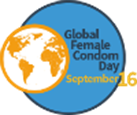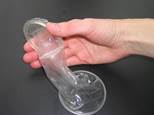
GLOBAL FEMALE CONDOM DAY

September 16 marks the fifth annual day of action in support of Global Female Condom Day!
GFCD advocates are collecting descriptions of your visions for the future of the female condom. Responses will be compiled and used to develop an advocacy tool for use in your efforts to expand and improve access to the female condom. To contribute your ideas for the female condom's future, you can use their online poll between 8 a.m. and 11 p.m. in your local time zone at: PollEv.com/gfcd2016, Tweet @nationalfccoalition, or text GFCD2016 to 22333. To share your support online, check out this compilation of social media messages created by GFCD organizers.
For another way to spread the word about female condoms, consider attending a local Cupcakes and Condoms event hosted by The Red Pump Project. This year they are touring ten US cities to host events that provide a forum for women and adolescent girls to learn about HIV and STI prevention. The events include female condom demonstrations as part of an effort to increase awareness of the full spectrum of choices that women and girls have available. Details about each local event are available online and many are happening during the next two months.
FEMALE CONDOMS AT 2016 OLYMPIC GAMES
Concerns about the Zika virus in the context of the 2016 Olypmic Games in Brazil brought additional attention to the benefits of the female condom. For the first time, female condoms were included in the safer sex products provided to Olympic athletes.  100,000 female condoms were allocated for distribution in Rio. As reported in The Guardian, over 450,000 male and female condoms were provided, and the record number is attributed in part to the first inclusion of the female condom in the products made available by the International Olympics Committee. 100,000 female condoms were allocated for distribution in Rio. As reported in The Guardian, over 450,000 male and female condoms were provided, and the record number is attributed in part to the first inclusion of the female condom in the products made available by the International Olympics Committee.
ZIKA PREVENTION RECOMMENDATIONS INCLUDE FEMALE CONDOMS
As the NY Post reports, female condoms have also been included in "Zika prevention kits" distributed by the US Centers for Disease Control and Prevention. The CDC continues to update its recommendations for Zika prevention as new cases are reported. The inclusion of the female condom in their safer sex recommendations is an important step toward highlighting this important method of protection. The Brazilian Ministry of Health has reportedly also highlighted the benefit of the female condom in efforts to prevent Zika transmission.
The call for downclassification -- or reclassification -- of the female condom by the US Food and Drug Administration is discussed in-depth in an article in The Body. The advocacy campaign launched by the National Female Condom Coalition aims to have the female condom classification changed from Class III, the regulatory category used for newly introduced devices, to Class II, the same category as the male condom. The benefits of downclassification include reducing regulatory barriers for new female condom development and marketing in the US, a potential increase in consumer interest by broadening the range of products available, expanding safer sex options, and a likely shift in international markets whose own regulatory bodies model their product classifications on decisions made by the US FDA.
In a June 2016 article in The Atlantic, Christine Ro follows the history of the female condom from its design and development of the first polyurethane design in the 1980's through new productive development and the shifting popularity and diversity of options available today. Ro also explores the interplay between the limited attention the female condom receives and higher production cost as compared to the male condom and links it to a decline in popularity in the United States. The incorporation of the female condom in international markets and the use of social marketing techniques to expand markets and increase the visibility and popularity of the female condom are also examined.
|

